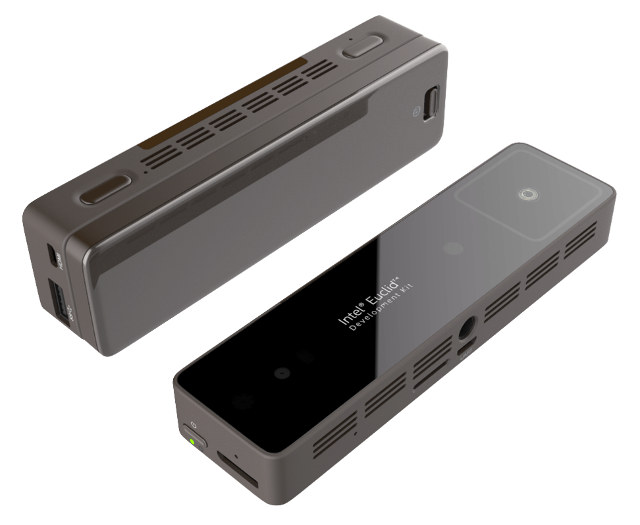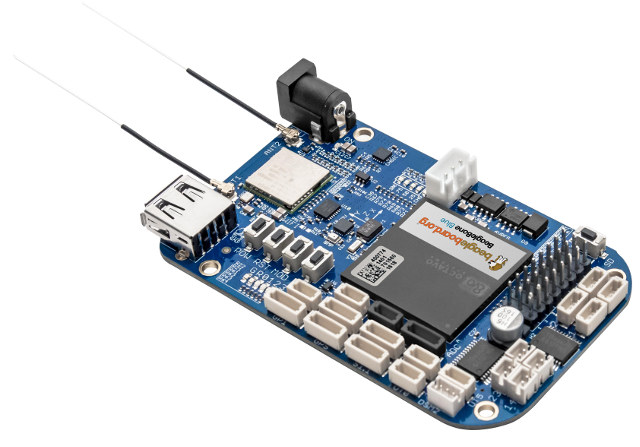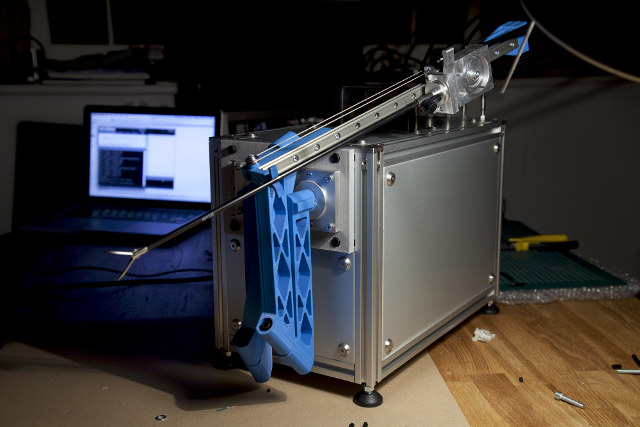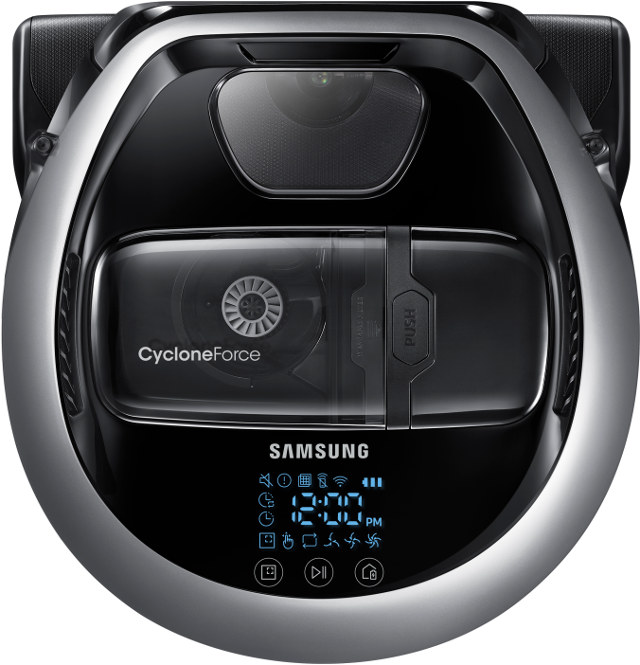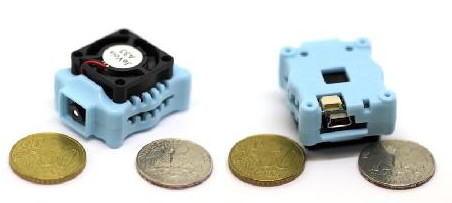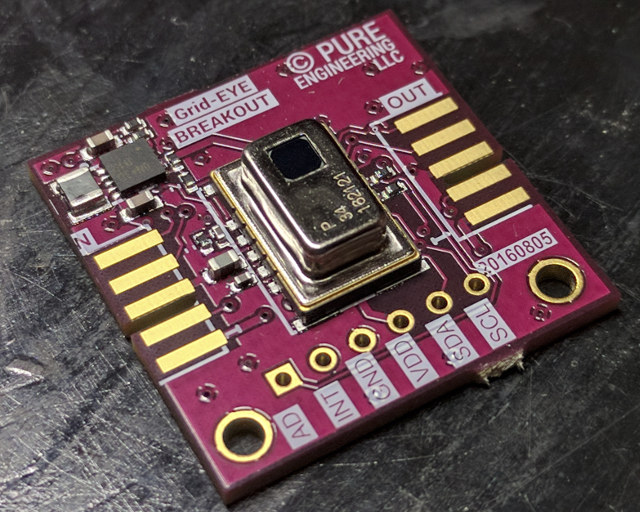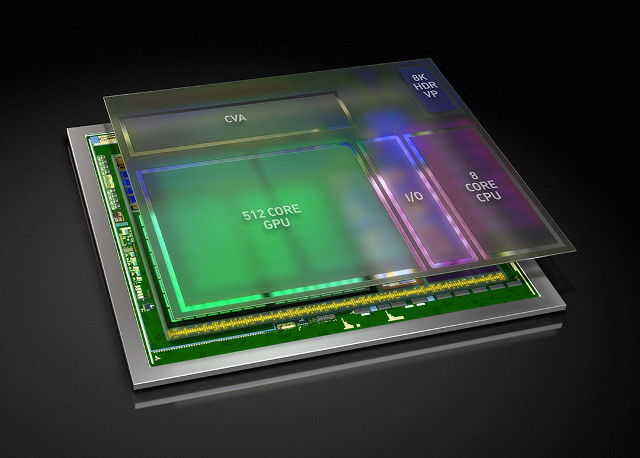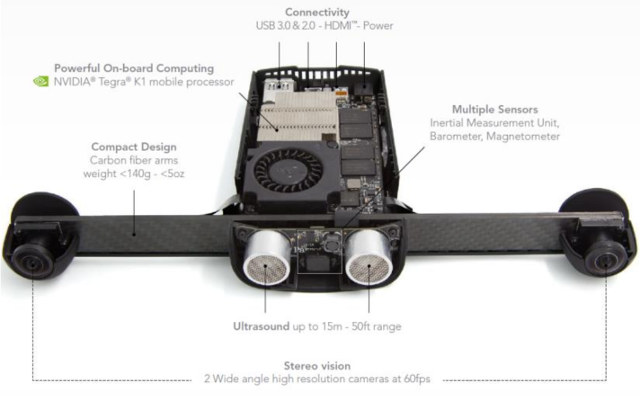We’ve seen many mini PC based on Intel Atom x5/x7 “Cherry Trail” processor in the last year, but Intel has also integrated their low power processor into hardware aimed at robotics, such as Intel RealSense development kit based on Atom x5 UP Board and RealSense R200 depth camera. The company has now launched its one-in-all Intel Euclid development kit combining Atom X7-Z8700 processor with a RealSense camera in a single enclosure. Intel Euclid specifications: SoC – Intel Atom x7-Z8700 Cherry Trail quad core processor @ up to 2.4GHz with Intel HD Graphics Gen 8 System Memory – 4GB LPDDR3-1600 Storage – 32GB eMMC 5.0 flash, Micro SD slot up to 128GB Video Output – micro HDMI port up to 4K @ 30 Hz Audio – 2x I2S interfaces, 1W mono speaker, 3x DMIC with noise cancellation Camera – Intel RealSense ZR300 camera RGB camera – 2MP up to 1080p@30fps, 16:9 […]
$80 BeagleBone Blue Board Targets Robots & Drones, Robotics Education
Last year, we reported that BeagleBoard.org was working with the University of California San Diego on BeagleBone Blue board for robotics educational kits such as EduMiP self-balancing robot, and EduRover four wheel robot. The board has finally launched, so we know the full details, and it can be purchased for about $80 on Mouser, Element14 or Arrow websites. BeagleBone Blue specifications: SiP (System-in-Package) – Octavo Systems OSD3358 with TI Sitara AM3358 ARM Cortex-A8 processor @ up to 1 GHz, 2×32-bit 200-MHz programmable real-time units (PRUs), PowerVR SGX530 GPU, PMIC, and 512MB DDR3 Storage – 4GB eMMC flash, micro SD slot Connectivity – WiFi 802.11 b/g/n, Bluetooth 4.1 LE (TI Wilink 8) with two antennas USB – 1x USB 2.0 client and host port Sensors – 9 axis IMU, barometer Expansion Motor control – 8x 6V servo out, 4x DC motor out, 4x quadrature encoder in Other interfaces – GPIOs, 5x UARTs, 2x […]
Open Surgery Initiative Aims to Build DIY Surgical Robots
Medical equipments can be really expensive because of the R&D involved and resulting patents, low manufacturing volume, government regulations, and so on. Developed countries can normally afford those higher costs, but for many it may just be prohibitively expensive. The Open Surgery initiative aims to mitigate the costs by “investigating whether building DIY surgical robots, outside the scope of healthcare regulations, could plausibly provide an accessible alternative to the costly professional healthcare services worldwide”. The project is composed of member from the medical, software, hardware, and 3D printing communities, is not intended for (commercial) application, and currently serves only academic purposes. Commercial surgical robots can cost up to $2,000,000, but brings benefits like smaller incisions, reduced risks of complications and readmissions, and shorter hospital stays thanks to a faster recovery process. There have already been several attempts within the robotics community to come up with cheaper and more portable surgical […]
Samsung Introduces IoT-Ready POWERbot VR7000 Robot Vacuum Cleaner Compatible with Amazon Echo
2017 is the year where the future starts. You’ll be wandering in your automated home or office where lights and heating system are fully handled by a gateway taking into account sensors values, and equipped with a CO2 level controlled ventilation systems, your eyes constantly looking at your phone, wearing neckband speakers likely connected to your Amazon Echo to let you know when it’s time to get up, eat, go to work, brush your teeth, and get back to bed again. All your life will be taken care of on your behalf by the Internet of Things, relieving you of the stress of taking routine daily decisions… Luckily, you’ll still be have an illusion of control thanks to your “IoT-ready” Samsung POWERbot VR7000 vacuum cleaner that can be controlled with your voice via that Echo thing, giving your life a purpose. Samsung Electronics’ latest POWERbot vacuum cleaner will be unveiled […]
JeVois-A33 is a Small Quad Core Linux Camera Designed for Computer Vision Applications (Crowdfunding)
JeVois Neuromorphic Embedded Vision Toolkit – developed at iLab at the University of Southern California – is an open source software framework to capture and process images through a machine vision algorithm, primarily designed to run on embedded camera hardware, but also supporting Linux board such as the Raspberry Pi. A compact Allwinner A33 has now been design to run the software and use on robotics and other projects requiring a lightweight and/or battery powered camera with computer vision capabilities. JeVois-A33 camera: SoC – Allwinner A33 quad core ARM Cortex A7 processor @ 1.35GHz with VFPv4 and NEON, and a dual core Mali-400 GPU supporting OpenGL-ES 2.0. System Memory – 256MB DDR3 SDRAM Storage – micro SD slot for firmware and data 1.3MP camera capable of video capture at SXGA (1280 x 1024) up to 15 fps (frames/second) VGA (640 x 480) up to 30 fps CIF (352 x 288) […]
Grid-EYE Breakout Board is a $49 Low Resolution Thermal Camera Module
Thermal cameras can be really expensive pieces of equipment, and even the cheap 60×60 thermal cameras available on Aliexpress costs a little over $200. However, PURE Engineering has made an breakout board with Panasonic Grid-EYE infrared 8×8 array sensor that allows you to experiment with the technology, or integrate into your own projects for just $49. Grid-EYE breakout board features: Panasonic Grid-EYE AMG8834 64 pixel infrared / thermal camera sensor with 60 degree viewing angle using MEMS thermopile technology Pinout compatible with Arduino Zero, ST-NUCLEO board, and other 3.3V boards with I2C, VDD, GND, INT, and AD pins PUREModules PCB edge connectors with UART, GPIO, to interface with the company’s IoT board Power Supply – On-board regulator handles 3 to 5V input The Panasonic sensor transfers thermal presence, direction, and temperature values over I2C. The company wrote a demo for the module with an Arduino sketech and a Processing sketch […]
Nvidia Unveils Xavier Automotive & AI Octa-core SoC with 512-Core Volta GPU, 8K Video Decode & Encode
Nvidia has introduced the successor to their Parker SoC mostly targeting self-driving cars and artificial intelligence applications, with Xavier SoC featuring 8 custom ARMv8 cores, a 512-core Volta GPU, a VPU (Video Processing Unit) supporting 8K video decode and encode and HDR (High Dynamic Range), as well as a computer vision accelerator (CVA). The processor will deliver 20 TOPS (trillion operations per second) of performance, while consuming only 20 watts of power, and since it’s designed specifically for autonomous cars, it will comply with automotive safety standards such as ISO 26262 functional safety specification. Anandtech published a comparison table with Tegra X1 (Erista), Parker, and Xavier using currently available information. Xavier Parker Erista (Tegra X1) CPU 8x NVIDIA Custom ARM 2x NVIDIA Denver + 4x ARM Cortex-A57 4x ARM Cortex-A57 + 4x ARM Cortex-A53 GPU Volta, 512 CUDA Cores Pascal, 256 CUDA Cores Maxwell, 256 CUDA Cores Memory ? LPDDR4, […]
Parrot S.L.A.M Dunk is a Ubuntu & ROS Computer with 3D Depth Cameras for Drones & Robots
Parrot and Canonical have partnered to develop the Parrot S.L.A.M.dunk development kit for the design of applications for autonomous navigation, obstacle avoidance, indoor navigation and 3D mapping for drones and robots, and running both Ubuntu 14.04 and ROS operating systems. The name of the kit is derived from its “Simultaneous Localization and Mapping algorithm” (S.L.A.M) allowing for location without GPS signal. Parrot S.L.A.M Dunk preliminary specifications: SoC – NVIDIA Tegra K1 processor Camera – Fish-eye stereo camera with a 1500×1500 resolution at 60fps Sensors – Inertial-measurement unit (IMU), ultrasound sensor up to 15 meters range, magnetometer, barometer Video Output – micro HDMI USB – 1x micro USB 2.0 port, 1x USB 3.0/2.0 port Weight – 140 grams Parrot S.L.A.M dunk can be fitted various drones and robotic platforms such as quadcopters and fixed-wings, rolling robots and articulated arms using mounting kits. The computer module is then connected to the host […]


